Think-feel and Know-act
© Copyright 1979 by Ralph E. Kenyon, Jr.
One of the key notions of general semantics, indicated by the extensional
device 'etc.', can be stated that any given theory "has not said it
all." Another important notion of general semantics, for which the term
'elementalism' has been developed, is that a pair of terms may represent a
verbal split of something that cannot be split non-verbally, such as body-mind.
What I will discuss can be previewed using these two notions. I am going to
examine two "theories" about "thinking" and
"feeling" and begin with the notion that each of these theories is a
part of the "etc." of the other theory and that, taken separately,
each is an "elementalism". That which is elementalistically split may
be reunited. I will propose a theory which "hyphenates" or unites
these two theories.
One non-elementalistic theory may be put together from the parts. Harry
Holtzman, in another context, said, "... you have to differentiate in order
to integrate ...". Well, Harry, I will assume that the two theories, taken
separately, are such a differentiation. I will then integrate the two theories
(analogous to using the extensional device '-' [the hyphen] in 'think-feel') to
arrive at a greater whole theory which has each of the others as a
"part". In order to achieve a "fit", some minor
modifications may be required. Also, I will consciously abstract from the
complex synthesis a relatively simple representation in order to stay within the
scope of this paper as I intend it.
So far, I have made statements at sufficiently high orders of abstracting to
preclude the identification of details of my hypothesis. So I will proceed to a
more "objective" level, or as they say in the legal profession,
"It's time to get down to cases."
That aspect, abstraction, facet, etc., of general semantics which
illustrates, indicates, models, etc., human "knowing", is called the
'structural differential'. (1)
This device, model, etc., makes two differentiations. It differentiates among
the "event level" (represented by the parabola or what Bois called
"what is going on [WIGO]", (2))
the "object level" (represented by the circle), and the "verbal
level(s)" (represented by the label shaped tags). In most discussions of
the "process", it is generally accepted that as the
"process" proceeds, representation of "characteristics" and
"properties" is transformed [transduced] from the event level to the
object level to the verbal levels. Implicit but often unstated in popular
discussions is also that the model represented by the structural differential is
a "map" of the way we infer that human nervous systems respond to and
process information. Roughly, we are able to "sense" (object level)
some of the characteristics in our environment (the event level) [Strictly
speaking, our senses TRANSDUCE from the characteristics into our
representations.] and select from what we sense to speak (verbal levels) of even
fewer characteristics in our environment. Without going further into the details
of the model, then, we can say that we sense, select, and verbalize about 'what
is going on' [what we INFER is going on]. In order to verbalize about what we
sense, we must decide what terms to apply to what we experience at non-verbal
levels. A three term, sequential description of this process is then,
successively, "sense", "select", and "decide".
Of course, decisions are limited by the structural complexity of our
individual experience with terms; the Sapier-Whorf-Korzybski hypothesis is that
what we experience on the non-verbal level is largely determined by our verbal
experience. I like to say "As we transform [transduce, etc.] our non-verbal
experience into verbalizations, we do so into PRE-EXISTING verbal structures
(which gets into Korzybski's "circularity of knowledge")". To get
back to my purpose, for now, I am only interested in the three steps
"sense", "select" and "decide". Notice that I am
using VERBS to continually make the PROCESS aspect apparent. This theory, has an
"etc." and is itself part of the "etc." of another, related,
theory. Let us now look at that other theory.
Part of the activity of The Institute of General Semantics involves enhancing
the non-verbal awareness of students. This facet of general semantics is
grounded in some theoretical research in Psychology. During the late forties and
early fifties, research was done is an area known as "Attitude
Psychology". Attitude Psychology deals with the relation of the
"mind" to the "body" by looking at physical attitudes. In
the elementalistic view, "emotion" belongs to "mind" and
"posture" belongs to "body". What happens if we believe that
the term 'body-mind' reflects a more accurate structural representation? We then
must look at "emotion" and "posture" as structurally more
correctly represented by 'posture-emotion'. The possibility of just such a
relation was examined by Nina Bull during the period 1947 thru 1948. (3)
I shall summarize her "findings" tersely. As a result of her
experiments, she concluded that there is a relation between the
"feelings" we report associated with an "emotion" and the
"motor attitude" ("posture" or "position")
associated with the behavior appropriate to the "emotion". Further, a
quantitative change in the "feelings" results from a change in the
timing of the expressive behavior. The summary description is that, for each of
the "emotions" studied, there is a particular complex of motor
attitudes which is uniquely associated with that "feeling"
("emotion"). Moreover, delay in the onset of appropriate behavior
increases, enhances, amplifies, etc., that feeling. In other words, there is a
particular posture for each emotion and waiting intensifies the feelings.
Sequentially, then, the body assumes a particular orientation or
"orients" (adopts a particular motor attitude) in preparation for a
particular behavior, feels the "feelings" of that potential act, and
then carries out the appropriate behavior. Delaying the behavior intensifies the
feelings. Incidentally, the mechanism proposed for feeling is that what we
experience (at one level) "is" the result of integrated and summed
(into a gestalt) proprioceptive and interoceptive feedback associated with that
particular orientation (motor attitude). [It's different for different attitudes
-- "explaining" why the feelings of different "emotions"
seem "similar" but different.] To get back to my point, the three
stages in the process are: to "orient" (take a motor attitude),
"feel" (experience the integrated feedback) and "act"
(engage in behavior which is a follow-thru of the motor attitudes or
orientation).
Nina Bull's studies looked at for six major "emotions" or
"feeling- states" characterized by the terms: 'joy', 'triumph',
'fear', 'anger', 'disgust' and 'depression'. What is significant to my synthesis
is the process sequence of "orient", "feel" and
"act" as well as the "amplification" effect of delayed
behavior. Here the delay refers to the physical time between the onset of the
orientation and the onset of the action or behavior (overt action). If the
organism or person is prevented from acting, whether by external or internal
sources, the feelings are intensified, amplified, etc., until the action
commences or another orientation is taken. This theory, is part of the
"etc." of the fist theory I mentioned earlier.
At this point, we are talking about what could be called the
"output" processes. What are these outputs responses to? How does each
person "know" what the emotion "feeling-state" is a response
to? In addition to past learning, the immediate inputs come from the processes I
wrote of earlier: sense, select and decide. The immediate orientation is
primarily a result of the sense-select-decide process. We "orient" to
(or away from) what we decide "is" good (or bad). To represent the
input-output process as-a-whole suggests the rather cumbersome term
'sense-select-decide-orient-feel-act'. This "term" shows the
structural relations among the "parts" or "sub-processes" in
organismic responding within environments. I am, of course, examining the
"structurally determined" aspect of our processing in light of our
inferences about our structure from these two different sources (Attitude
Psychology and general semantics). Our own behavior is a part of the "wigo",
however, so, as we behave, we sense some of the characteristics of our own
actions. What I have described so far lends itself very well to a visual
description as shown in Figure 1.
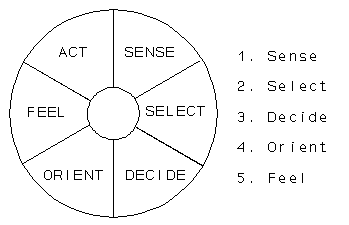 |
Figure 1. The six sub-processes involved in human responses
to incoming stimuli.
Instead of talking about "stimulus" and
"responses", or even the "internal" two-stage process
"input-output", we have a more substantial model with six
sub-processes. It is also possible to relate these other approaches to
this model. Figure 2 shows the relationships.
|
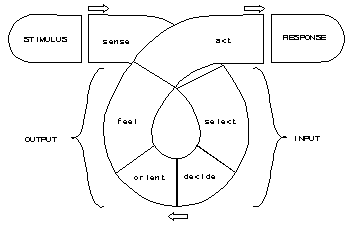 |
Figure 2. Relations among S-R, I/O, and the six stage
model.
What is sensed represents characteristics (in the WIGO) of the
"stimulus" and the behavior (and result) is the
"response". This "Six Stage Information processing
Model" (STIM) of human "knowing-acting" provides a
synthesis of attitude psychology and the structural differential and shows
the relation of STIM to behaviorism in terms of stimulus and response.
|
I wish to add one more degree of complexity to the model by
"stacking" several sections (as shown in Figure 2)
together to form a spiral. Each successive section represents another sequence
in time. I will then examine the relationships between the individual processes
from section to section to section (from time-1 to time-2). Figure 3 shows the
spiral form of the model at this stage.
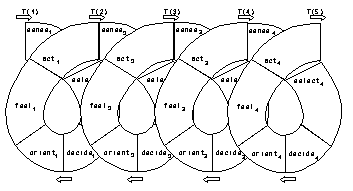
Figure 3. Six stage model with time-binding.
Each of the six sub-processes can be examined with regard to time-binding.
For example, over time, the "same" behavior given in response to
similar situations is usually called "habit". Moreover, if we
"always" decide the "same way" in response to similar
situations, we say the decision represents an expression of a "value".
In a similar manner, the time-binding of motor attitude (orient) is
"posture", of feeling is "emotion", of selecting is
"filter" and of sensing is "attention". One way to represent
these "time-bound" relations is by showing a connection through each
of the different time sections. Visual representation of this structure is shown
in Figure 4.
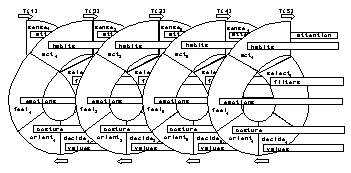
Figure 4. Six stage model with time-binding and time-bound resultants for each
of the six stages. (full six stage model). - {bonus:
color image}
It is to be explicitly noted that this model or theory, which is a six stage
information-processing model, is an abstract map of the structure-functioning of
human knowing and acting which does not say "all". The question would
be: "As far as it does go, how well does it 'explain' the data?" One
thing this model provides insight for is the great deal of difficulty we
experience whenever we try to change someone's "mind", to deal with
prejudice, to deal with what management calls "attitude problems", and
etc. Discussions which concentrate on the decision-value stage ignore the other
five stages. Behavior modification, which concentrates on action-habits
(behavior), also ignores the other five stages. Perhaps this is why so many
attempts to get changes in people's ways of doing things fail. It would be
interesting to see what happened if someone tried using all six stages in their
plan. In psychology, "cognitive dissonance theory" can be paraphrased
that people cannot function for long periods of time having "values"
and "action" not concordant. STIM shows a structure-functional reason
for behavior and values to be in agreement.
Using the single level version of the model (see Figure 1.),
I am able to point to what I understand the terms 'cognitive', 'affective' and
'behavioral' refer to. 'Cognitive' refers to "sense-select-decide"
(and "attention-filter-value"); 'affective' refers to
"decide-orient-feel" (and "value-posture-emotion"); and
'behavioral' refers to "act" (and habits). Figure 5
illustrates the relationships.
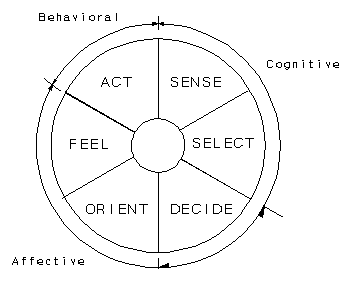 Figure 5. Six stage model as related to 'classical' psychological distinctions.
Figure 5. Six stage model as related to 'classical' psychological distinctions.
The same "physical" structure underlies both the input and the
output sides of the process. It seems reasonable to assume that there is a
similarity in the structure-function-process between the input and the output
processes. One of Nina Bull's results (output process) can be stated: delayed
behavior amplifies feelings. It seems reasonable to expect a similar effect for
the input process. Before stating that prediction, one thing we must recall is
that our sensing process includes "internal" as well as external
sensing. Memory is one such internal sense. When the "decide" process
is delayed, there is more time for this internal sensing to take place as well
as for more stages of "selecting" to occur. When this additional time
is considered, the terms 'select' and 'filter' become somewhat limited. The
phrase 'represents more abstractedly while including more memory and
association' more accurately represents the process. For now, at the risk of
some loss from abstracting, I am "selecting" the single term 'think'
to shorthandedly represent the process.
To state the prediction, it seems reasonable to expect that the same
amplification occurs during input prossing as was observed during output
processing. Precisely stated: delayed decision amplifies thinking. This result
is hardly surprising. General semantics principles suggest that "delayed
responses" are more symbolic and more likely to be "appropriate".
To the extent that the delay is included in the input side, more memory and
associations can be included in developing the subsequent action. Such responses
are termed (by general semantics) 'symbol responses' whereas immediate responses
which do not have time to include much memory and associations are termed
'signal reactions'.
We can enhance our ability to respond to our environments
"appropriately" by enhancing our awareness of
"attention-filters-values-postures-emotions-habits". Additionally,
consciousness of our own "sense-select-decide-orient-feel-act" process
can further enhance our effectiveness in responding to our varied environments.
I hasten to point out that these inferences derive from the
"structurally-determined" consideration, however, are inferences
derived from the consideration of other reasonable inferences developed from
scientifically structured experiments. As such they are "second order"
inferences from observations and represent a relatively more abstract structure.
In summary, by integrating the basic model of general semantics, the
structural differential, with the basic principles of the attitude theory of
emotion, an information-processing model of human functioning results. This
model depicts the structurally-determined process-function in six stages and
illustrates the interaction among these stages. This "knowledge" is
inferential and somewhat speculative (an extrapolation); however, I have found
applications in management as well as in explaining day-to-day human behavior.
Modern group dynamics techniques deals with the "whole" person by
taking into consideration posture (body language and non-verbal communications),
values (values clarification exercises), feelings (sensitivity training),
attention (selective perception), "filters", and behavior (commitment
to follow through with action). I personally use the model in communications by
being alert to the other person's attention, values, posture, etc. On how many
occasions have you gone over (several times) what seems to be a flawless
argument (verbal level dealing primarily with "decide") only to have
it rejected for no VALID reason? Such an argument deals with only one
sub-process. Similarly, when behavior is forced, once the force is removed, the
behavior reverts back. Etc., etc.
Another application of this "theory" (STIM) is a prediction about
teaching. To get effective learning, we should get the act (behavior) into the
system as well as input. One example of implementing this would be to have
students "output". STIM, therefore, predicts that learning will be
more effective if the attention, decision process, posture, feelings and actions
of the student can all be involved. It also suggests that attention should be
given to the individual filters or selective perceptions of the participants.
The model also suggests that dealing with prejudice is not likely to be
successful unless the person can be gotten "fully" involved. It seems
that at least three and probably four of the sub-processes must be included for
lasting changes to occur.
RALPH KENYON
EXTRAPOLATOR
APR 12, 1979 |
References
1. Alfred Korzybski, Science and Sanity, 4th ed., The
International Non-Aristotelian Library Publishing Company, Lakeville, 1958 Back
to document
2. J. Samuel Bois, The Art of Awareness, 2ond ed., Wm.
C. Brown Company, Duboque, 1966 Back to document
3. Nina Bull, The Attitude Theory of Emotion, Nervous
and Mental Diseases Monographs No. 81, Coolidge Foundation, New York, 1951 Back
to document
Annotated bibliography of general semantics papers
General Semantics and Related Topics
| This page was updated by Ralph Kenyon on
2018/04/14 at 11:14
and has been accessed
27362
times at
103
hits per month.
|
|---|




 Figure 5. Six stage model as related to 'classical' psychological distinctions.
Figure 5. Six stage model as related to 'classical' psychological distinctions.